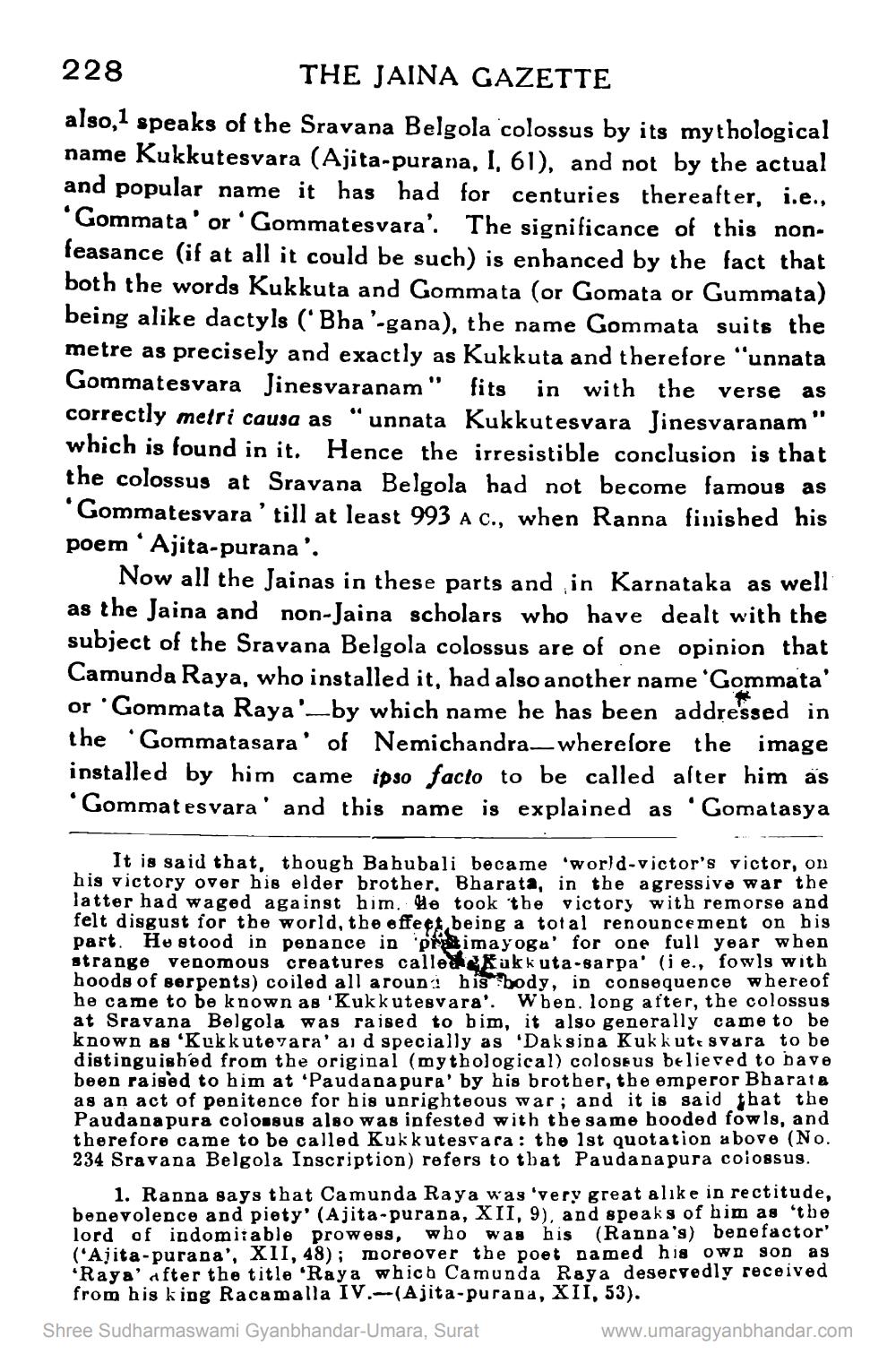________________
228
THE JAINA GAZETTE also, 1 speaks of the Sravana Belgola colossus by its mythological name Kukkutesvara (Ajita-purana, I, 61), and not by the actual and popular name it has had for centuries thereafter, i.e., 'Gommata' or 'Gommatesvara'. The significance of this nonfeasance (if at all it could be such) is enhanced by the fact that both the words Kukkuta and Gommata (or Gomata or Gummata) being alike dactyls ('Bha'-gana), the name Gommata suits the metre as precisely and exactly as Kukkuta and therefore "unnata Gommatesvara Jinesvaranam" fits in with the verse as correctly metri causa as "unnata Kukkutesvara Jinesvaranam" which is found in it. Hence the irresistible conclusion is that the colossus at Sravana Belgola had not become famous as 'Gommatesvara 'till at least 993 A C., when Ranna finished his poem 'Ajita-purana'.
Now all the Jainas in these parts and in Karnataka as well as the Jaina and non-Jaina scholars who have dealt with the subject of the Sravana Belgola colossus are of one opinion that Camunda Raya, who installed it, had also another name 'Gommata' or 'Gommata Raya'-by which name he has been addressed in the 'Gommatasara' of Nemichandra— wherefore the image installed by him came ipso facto to be called alter him as 'Gommatesvara' and this name is explained as 'Gomatasya
It is said that, though Babubali became 'world-victor's victor, on his victory over his elder brother. Bharata, in the agressiva war the latter had waged against him. He took the victory with remorse and felt disgust for the world, the effeet, being a total renouncement on bis part. Hustood in penance in pratimayoga' for one full year when strange venomous creatures called kukkuta-sarpa' (ie., fowls with hoods of serpents) coiled all aroun: his body, in consequence whereof he came to be known as 'Kukk utesvara'. Wben. long after, the colossus at Sravana Belgola was raised to bim, it also generally came to be known as 'Kukkutevara' aid specially as 'Daksina Kukkutt svara to be distinguished from the original (mythological) coloseus believed to bave been raised to him at Pauda na pura' by his brother, the emperor Bharate as an act of penitence for his unrighteous war; and it is said that the Paudanapura colossus also was infested with the same hooded fowls, and therefore came to be called Kukkutessara: the 1st quotation above (No. 234 Sravana Belgola Inscription) refers to that Paudana pura colossus.
1. Ranna says that Camunda Raya wag 'very great alıke in rectitude, benevolence and piety' (Ajita-purana, XII, 9), and speaks of him as 't be lord of indomiiable prowess, who was his (Ranna's) benefactor' (Ajita-purana', XII, 48); moreover the poet named his own son as 'Raya' after the title 'Raya whicb Camunda Raya deservedly received from his king Racamalla IV.-(Ajita-purana, XII, 53).
Shree Sudharmaswami Gyanbhandar-Umara, Surat
www.umaragyanbhandar.com




